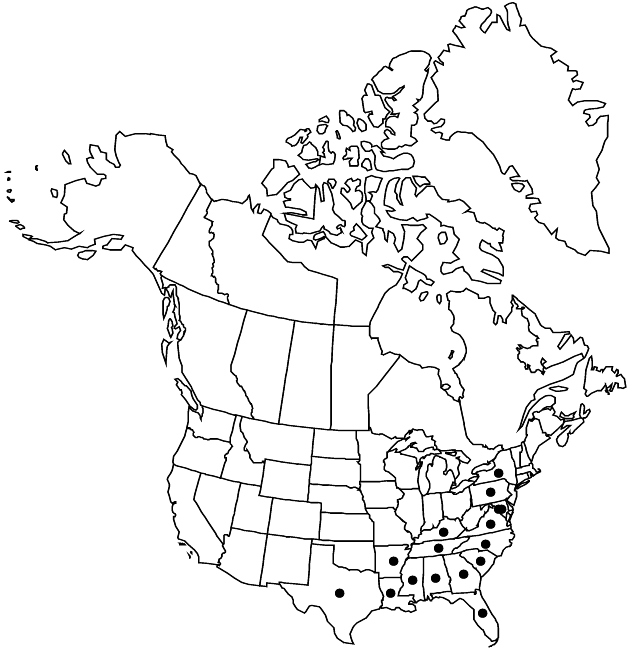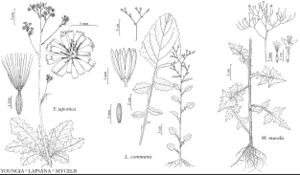Difference between revisions of "Youngia japonica"
in A. P. de Candolle and A. L. P. P. de Candolle, Prodr. 7: 194. 1838.
FNA>Volume Importer |
imported>Volume Importer |
||
| (One intermediate revision by the same user not shown) | |||
| Line 1: | Line 1: | ||
{{Treatment/ID | {{Treatment/ID | ||
|accepted_name=Youngia japonica | |accepted_name=Youngia japonica | ||
| − | |accepted_authority=(Linneaus) | + | |accepted_authority=(Linneaus) de Candolle |
|publications={{Treatment/Publication | |publications={{Treatment/Publication | ||
|title=in A. P. de Candolle and A. L. P. P. de Candolle, Prodr. | |title=in A. P. de Candolle and A. L. P. P. de Candolle, Prodr. | ||
| Line 38: | Line 38: | ||
|elevation=0–2400 m | |elevation=0–2400 m | ||
|distribution=Ala.;Ark.;D.C.;Fla.;Ga.;Ky.;La.;Md.;Miss.;N.Y.;N.C.;Pa.;S.C.;Tenn.;Tex.;Va.;se Asia;introduced also in Mexico;Central America;South America;Europe;Africa;Pacific Islands;Australia. | |distribution=Ala.;Ark.;D.C.;Fla.;Ga.;Ky.;La.;Md.;Miss.;N.Y.;N.C.;Pa.;S.C.;Tenn.;Tex.;Va.;se Asia;introduced also in Mexico;Central America;South America;Europe;Africa;Pacific Islands;Australia. | ||
| + | |introduced=true | ||
|discussion=<p><i>Youngia japonica</i> is now considered a pantropical weed. Relatively few specimens in the flora match what Babcock and Stebbins called subsp. elstonii, with cauline leaves almost as large as the basal and with conspicuous, lobed bracts at the bases of the proximalmost branches of the capitulescence. In subsp. japonica, to which most of our specimens are referred, the cauline leaves are much reduced or lacking, as are the bracts of the capitulescence.</p> | |discussion=<p><i>Youngia japonica</i> is now considered a pantropical weed. Relatively few specimens in the flora match what Babcock and Stebbins called subsp. elstonii, with cauline leaves almost as large as the basal and with conspicuous, lobed bracts at the bases of the proximalmost branches of the capitulescence. In subsp. japonica, to which most of our specimens are referred, the cauline leaves are much reduced or lacking, as are the bracts of the capitulescence.</p> | ||
|tables= | |tables= | ||
| Line 47: | Line 48: | ||
-->{{#Taxon: | -->{{#Taxon: | ||
name=Youngia japonica | name=Youngia japonica | ||
| − | |authority=(Linneaus) | + | |authority=(Linneaus) de Candolle |
|rank=species | |rank=species | ||
|parent rank=genus | |parent rank=genus | ||
| Line 62: | Line 63: | ||
|publication year=1838 | |publication year=1838 | ||
|special status= | |special status= | ||
| − | |source xml=https:// | + | |source xml=https://bitbucket.org/aafc-mbb/fna-data-curation/src/2e0870ddd59836b60bcf96646a41e87ea5a5943a/coarse_grained_fna_xml/V19-20-21/V19_340.xml |
|tribe=Asteraceae tribe Cichorieae | |tribe=Asteraceae tribe Cichorieae | ||
|genus=Youngia | |genus=Youngia | ||
Latest revision as of 20:51, 5 November 2020
Stems terete, fistulose. Leaves: petioles 1–10 cm, glabrous, puberulent, or densely hairy (hairs often brownish, crinkled); blades 3–12(–25) × 2–4(–6) cm, lateral lobes 0–20, mostly gradually reduced proximally, terminal lobes elliptic, ovate, obovate, or oblong-truncate, larger than laterals, apices obtuse or acute. Peduncles 1–5(–15) mm. Phyllaries 3.5–6 mm, bases and midribs becoming ± spongy, abaxial faces glabrous, glabrate, or hairy (hairs appressed, shining). Florets: corollas mostly 4.5–6.5 mm; anthers dark green (drying purplish); styles and style-branches yellow. Cypselae 1.5–2.5 mm, bases hollow, lightly calloused; pappi 2.5–3.5 mm, slightly surpassing phyllaries. 2n = 16.
Phenology: Flowering spring–summer (year-round south).
Habitat: Waste places, lawns, etc.
Elevation: 0–2400 m
Distribution

Introduced; Ala., Ark., D.C., Fla., Ga., Ky., La., Md., Miss., N.Y., N.C., Pa., S.C., Tenn., Tex., Va., se Asia, introduced also in Mexico, Central America, South America, Europe, Africa, Pacific Islands, Australia.
Discussion
Youngia japonica is now considered a pantropical weed. Relatively few specimens in the flora match what Babcock and Stebbins called subsp. elstonii, with cauline leaves almost as large as the basal and with conspicuous, lobed bracts at the bases of the proximalmost branches of the capitulescence. In subsp. japonica, to which most of our specimens are referred, the cauline leaves are much reduced or lacking, as are the bracts of the capitulescence.
Selected References
None.
